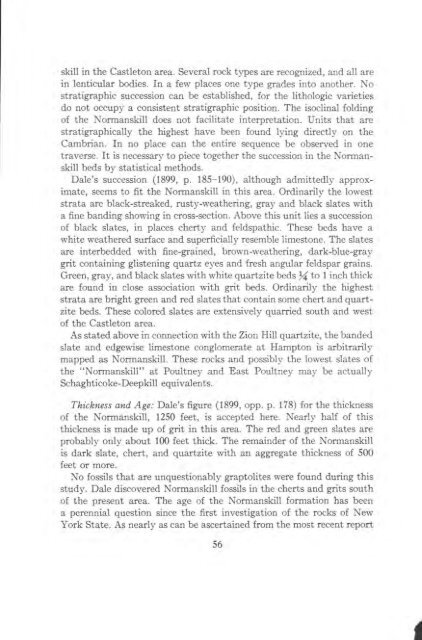STRATIGRAPHY AND STRUCTURE CASTLETON AREA VERMONT
STRATIGRAPHY AND STRUCTURE CASTLETON AREA VERMONT
STRATIGRAPHY AND STRUCTURE CASTLETON AREA VERMONT
Create successful ePaper yourself
Turn your PDF publications into a flip-book with our unique Google optimized e-Paper software.
skill in the Castleton area. Several rock types are recognized, and all are<br />
in lenticular bodies. In a few places one type grades into another. No<br />
stratigraphic succession can be established, for the lithologic varieties<br />
do not occupy a consistent stratigraphic position. The isoclinal folding<br />
of the Normanskill does not facilitate interpretation. Units that are<br />
stratigraphically the highest have been found lying directly on the<br />
Cambrian. In no place can the entire sequence be observed in one<br />
traverse. It is necessary to piece together the succession in the Normanskill<br />
beds by statistical methods.<br />
Dale's succession (1899, p. 185-190), although admittedly approximate,<br />
seems to fit the Normanskill in this area. Ordinarily the lowest<br />
strata are black-streaked, rusty-weathering, gray and black slates with<br />
a fine banding showing in cross-section. Above this unit lies a succession<br />
of black slates, in places cherty and feldspathic. These beds have a<br />
white weathered surface and superficially resemble limestone. The slates<br />
are interbedded with fine-grained, brown-weathering, dark-blue-gray<br />
grit containing glistening quartz eyes and fresh angular feldspar grains.<br />
Green, gray, and black slates with white quartzite beds Y4 to 1 inch thick<br />
are found in close association with grit beds. Ordinarily the highest<br />
strata are bright green and red slates that contain some chert and quartzite<br />
beds. These colored slates are extensively quarried south and west<br />
of the Castleton area.<br />
As stated above in connection with the Zion Hill quartzite, the banded<br />
slate and edgewise limestone conglomerate at Hampton is arbitrarily<br />
mapped as Normanskill. These rocks and possibly the lowest slates of<br />
the "Normanskill" at Poultney and East Poultney may be actually<br />
Schaghticoke-Deepkill equivalents.<br />
Thickness and Age: Dale's figure (1899, opp. p. 178) for the thickness<br />
of the Normanskill, 1250 feet, is accepted here. Nearly half of this<br />
thickness is made up of grit in this area. The red and green slates are<br />
probably only about 100 feet thick. The remainder of the Normanskill<br />
is dark slate, chert, and quartzite with an aggregate thickness of 500<br />
feet or more.<br />
No fossils that are unquestionably graptolites were found during this<br />
study. Dale discovered Normanskill fossils in the cherts and grits south<br />
of the present area. The age of the Normanskill formation has been<br />
a perennial question since the first investigation of the rocks of New<br />
York State. As nearly as can be ascertained from the most recent report<br />
56













